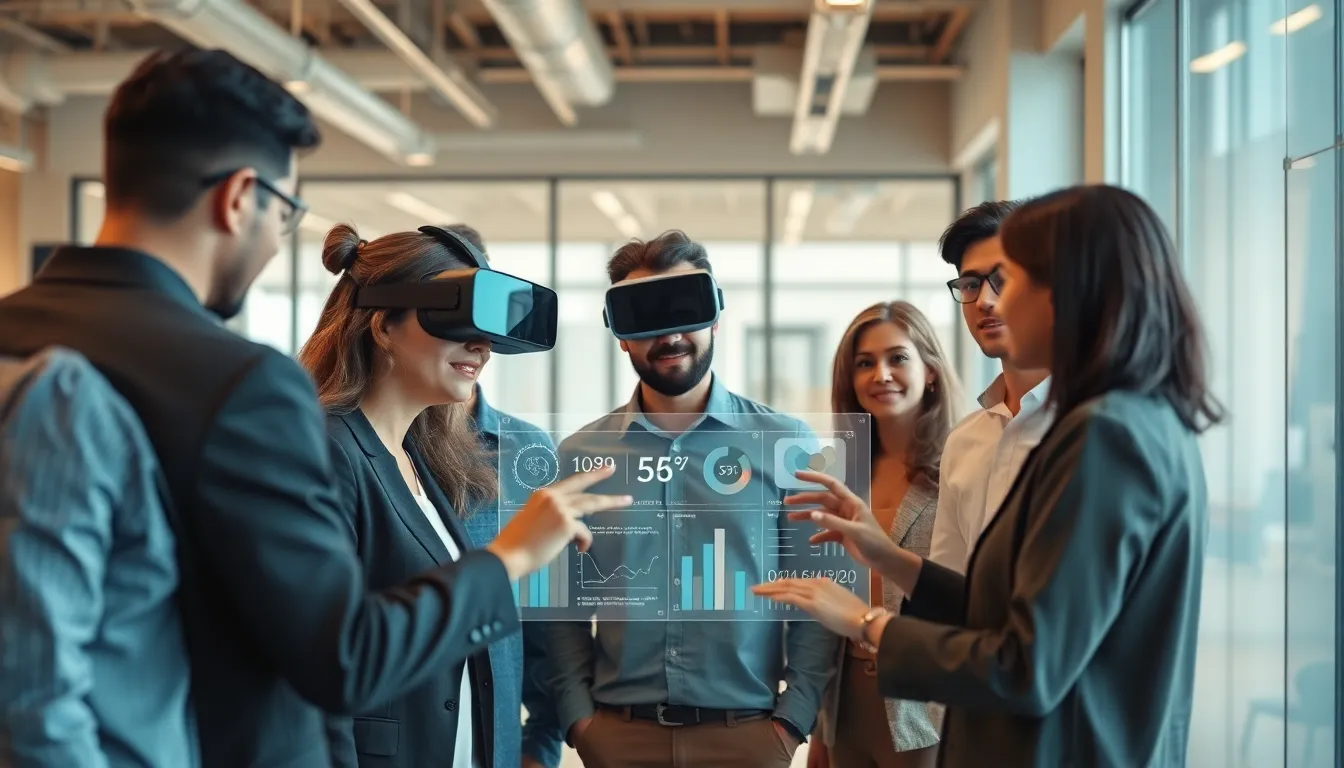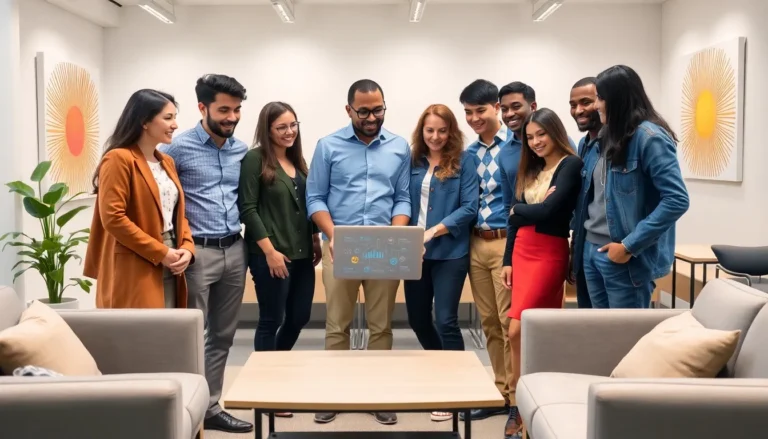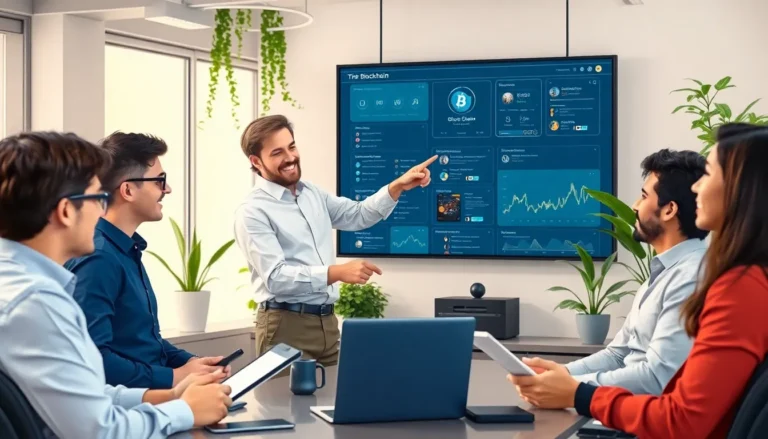In a world where smartphones are practically an extension of our arms and virtual assistants know our coffee orders better than our friends, the digital future is knocking at the door—and it’s bringing a whole lot of surprises. Imagine a life where your fridge orders groceries while you binge-watch your favorite shows, and your car drives you to work while you catch up on emails. Sounds like science fiction? Welcome to reality!
Table of Contents
ToggleThe Concept of Digital Future
Digital future envisions a world significantly influenced by technology and data integration. Smart devices, including refrigerators, vehicles, and home assistants, transform everyday tasks into automated processes. With these innovations, people experience increased convenience, allowing for better time management between leisure and work.
Artificial intelligence plays a crucial role in this future, enhancing decision-making and efficiency. Machine learning algorithms analyze data patterns, resulting in tailored experiences for consumers. Businesses leverage these tools to optimize operations, improving products and services continuously.
Connectivity expands beyond individual devices to entire ecosystems. The Internet of Things enables seamless communication among devices, fostering smart homes and cities. These interconnected systems collect data to enhance safety, energy usage, and overall quality of life.
With advancements in cloud computing, access to information becomes instantaneous. Users store and share data effortlessly, contributing to collaborative work environments and innovation. Remote work thrives in this landscape, encouraging diverse talent to participate in global projects.
Cybersecurity also rises as a priority in the digital future. As digital engagement increases, protecting sensitive information becomes essential. Organizations invest in advanced security measures, ensuring users can navigate online spaces confidently.
The digital future shapes not only technology but society as a whole. Education adapts to include digital literacy, preparing individuals for a technology-driven world. This shift emphasizes the importance of understanding digital tools, fostering a generation capable of thriving in an ever-evolving landscape.
Emerging Technologies Shaping the Digital Future

Emerging technologies are pivotal in defining the digital future. They’re reshaping interactions and experiences across various sectors.
Artificial Intelligence and Automation
Artificial intelligence serves as a cornerstone of automation in the digital landscape. This technology analyzes vast amounts of data to identify patterns, enabling businesses to enhance efficiencies. Automation streamlines tasks, allowing employees to focus on strategic priorities rather than routine jobs. Machine learning algorithms improve over time, consistently offering better insights and predictions. Companies are increasingly adopting AI for customer service, using chatbots to resolve inquiries quickly and efficiently.
Virtual Reality and Augmented Reality
Virtual reality and augmented reality redefine user experiences in profound ways. Virtual reality immerses users in simulated environments, popular in gaming and training applications. Augmented reality overlays digital information onto the physical world, creating interactive experiences in retail and education. These technologies enhance user engagement, making learning more immersive and fun. As both technologies advance, they open new avenues for social interaction, entertainment, and marketing.
Impact of Digital Future on Society
The digital future significantly transforms society in various ways. It influences how individuals connect and collaborate across different spheres of life.
Changes in Communication
New communication tools emerge daily, reshaping how people interact. Social media platforms enable instant sharing of ideas and experiences, connecting individuals globally. Video conferencing solutions make remote meetings feasible, breaking geographical barriers. Messaging apps facilitate real-time conversations, allowing for quick exchanges of information. As these technologies evolve, effective communication will remain paramount in both personal and professional realms.
Evolution of Work and Education
Digital advancements redefine the landscape of work and education. Telecommuting options expand, enabling flexible work environments that foster productivity. Online learning platforms offer diverse courses, allowing individuals to develop new skills at their own pace. Employers increasingly prioritize digital literacy, seeking proficient candidates for technology-driven roles. Lifelong learning becomes essential, adapting skills to an evolving job market. Educational institutions incorporate technology into curriculums, preparing students for future challenges and opportunities.
Challenges Ahead in the Digital Future
The digital future presents various challenges that need attention. Addressing these challenges is crucial for harnessing technology’s full potential.
Privacy and Security Concerns
Privacy issues surface as individuals share personal data online. Organizations face pressure to implement robust security measures, with 70% of consumers expressing concern about data breaches. Cyber threats evolve constantly, highlighting the need for advanced security protocols. Companies investing in cybersecurity solutions mitigate risks and protect sensitive information from unauthorized access. Transparency about data usage encourages trust, fostering better relationships between businesses and consumers. Policies surrounding data encryption and user consent become essential in maintaining privacy standards. A proactive approach ensures compliance with regulations, safeguarding user information in a digitally connected world.
Digital Divide and Accessibility
The digital divide remains a pressing challenge, affecting access to technology. Approximately 15% of the global population lacks reliable internet connectivity, limiting opportunities for education and employment. Disparities in access favor urban areas over rural regions, creating inequities. Efforts to bridge this gap involve investing in infrastructure and promoting affordable internet access. Inclusivity in technology design addresses accessibility needs, ensuring everyone benefits from digital advancements. Educational initiatives aimed at enhancing digital literacy empower individuals, fostering a more equitable society. Collaborations between governments and private sectors become critical in addressing these disparities, ultimately promoting broader access to digital resources.
The digital future holds immense potential for transforming everyday life and enhancing productivity. As technology continues to evolve and integrate into various sectors, individuals and businesses alike must adapt to these changes. Embracing advancements in artificial intelligence, connectivity, and immersive technologies will be crucial for thriving in this new landscape.
However, addressing challenges like cybersecurity and the digital divide is essential to ensure that everyone benefits from these innovations. By fostering collaboration between governments and private sectors, society can work towards a more inclusive digital environment. As the future unfolds, staying informed and adaptable will empower individuals to navigate the exciting opportunities that lie ahead.









